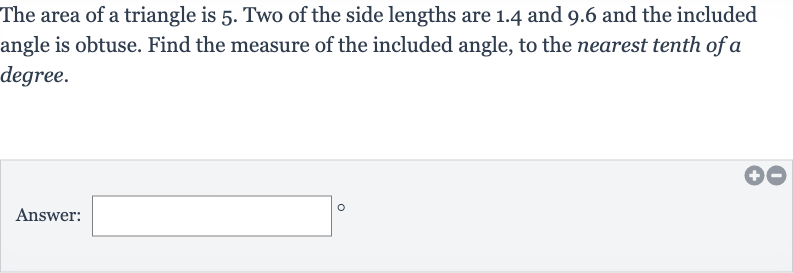AI tutor
Welcome to Bytelearn!
Let’s check out your problem:

The area of a triangle is . Two of the side lengths are . and . and the included angle is obtuse. Find the measure of the included angle, to the nearest tenth of a degree.Answer:
Full solution
Q. The area of a triangle is . Two of the side lengths are . and . and the included angle is obtuse. Find the measure of the included angle, to the nearest tenth of a degree.Answer:
- Area Formula Application: To find the measure of the included angle, we can use the formula for the area of a triangle, which is given by , where is the area, and are the lengths of two sides, and is the included angle between those sides.
- Substitute Values: We know the area , side , and side . We can plug these values into the area formula to solve for .
- Calculate Sine: The formula with the given values is .
- Find Reference Angle: Solving for , we get .
- Calculate Acute Angle: Calculating the denominator, we have .
- Find Obtuse Angle: Now, we can find by dividing the area by the product of the sides, which gives us .
- Find Obtuse Angle: Now, we can find by dividing the area by the product of the sides, which gives us .Performing the division, we get .
- Find Obtuse Angle: Now, we can find by dividing the area by the product of the sides, which gives us .Performing the division, we get .Since the angle is obtuse, we need to find the angle whose sine is approximately . and is greater than degrees but less than degrees.
- Find Obtuse Angle: Now, we can find by dividing the area by the product of the sides, which gives us .Performing the division, we get .Since the angle is obtuse, we need to find the angle whose sine is approximately . and is greater than degrees but less than degrees.Using the inverse sine function (also known as arcsin), we find the reference angle for the acute angle with the same sine value. However, since the calculator will give us the acute angle, we must subtract this value from degrees to find the obtuse angle.
- Find Obtuse Angle: Now, we can find by dividing the area by the product of the sides, which gives us .Performing the division, we get .Since the angle is obtuse, we need to find the angle whose sine is approximately . and is greater than degrees but less than degrees.Using the inverse sine function (also known as arcsin), we find the reference angle for the acute angle with the same sine value. However, since the calculator will give us the acute angle, we must subtract this value from degrees to find the obtuse angle.The reference angle is degrees, which we calculate using a calculator.
- Find Obtuse Angle: Now, we can find by dividing the area by the product of the sides, which gives us .Performing the division, we get .Since the angle is obtuse, we need to find the angle whose sine is approximately . and is greater than degrees but less than degrees.Using the inverse sine function (also known as arcsin), we find the reference angle for the acute angle with the same sine value. However, since the calculator will give us the acute angle, we must subtract this value from degrees to find the obtuse angle.The reference angle is degrees, which we calculate using a calculator.The calculator gives us an acute angle of approximately . degrees.
- Find Obtuse Angle: Now, we can find by dividing the area by the product of the sides, which gives us .Performing the division, we get .Since the angle is obtuse, we need to find the angle whose sine is approximately . and is greater than degrees but less than degrees.Using the inverse sine function (also known as arcsin), we find the reference angle for the acute angle with the same sine value. However, since the calculator will give us the acute angle, we must subtract this value from degrees to find the obtuse angle.The reference angle is degrees, which we calculate using a calculator.The calculator gives us an acute angle of approximately . degrees.To find the obtuse angle, we subtract the acute angle from degrees: degrees.
More problems from Inverses of trigonometric functions using a calculator
QuestionGet tutor help
QuestionGet tutor help
QuestionGet tutor help
QuestionGet tutor help
QuestionGet tutor help
QuestionGet tutor help
Question
. Find the value of in degrees.Write your answer in simplified, rationalized form. Do not round.____
Get tutor helpQuestionGet tutor help
